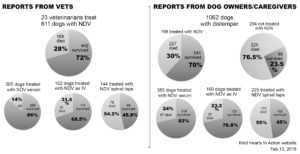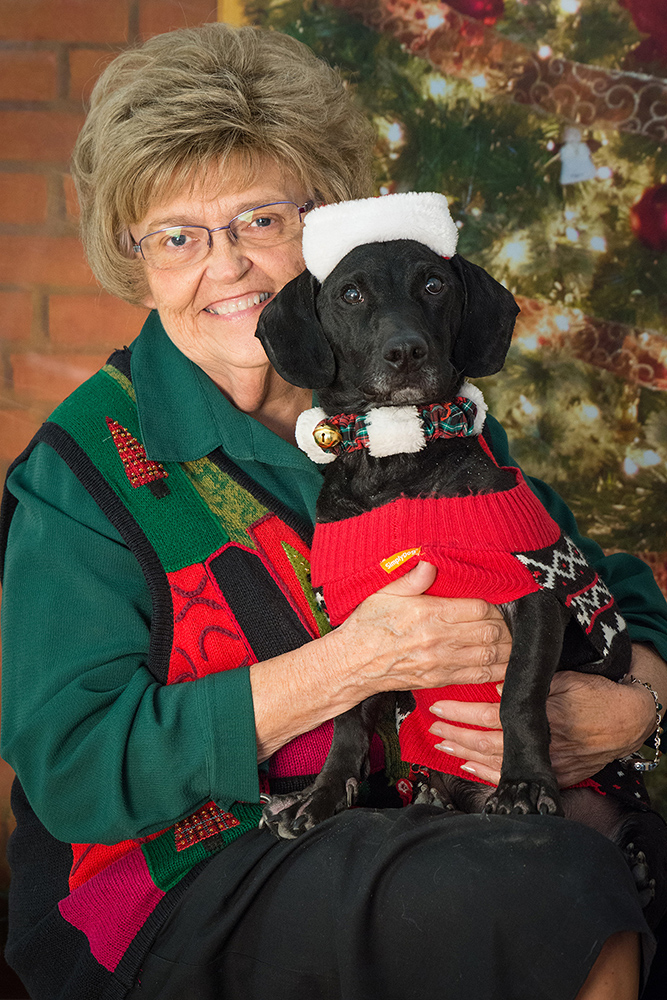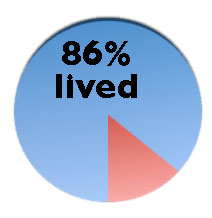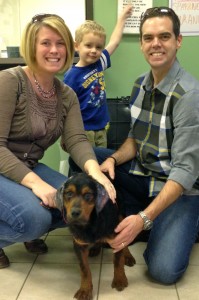
Statistics compiled by Kind Hearts In Action between December 2008 and February 2016.
NOTE: To clarify a couple of issues that have been raised, I’d like to make two points: 1) At no time do we call this a scientific study. This is just a report of numbers I have collected over the years. I understand this is nothing more than anecdotal information. We do not claim here to have proven there is a cure for canine distemper, but we think it would worthwhile to see a full study done. However, we do not have the means to conduct one ourselves. 2) As I say elsewhere throughout the website and on every email I send out, I am not a veterinarian, a doctor or a scientist. I never claim to be one. I do this as an attempt to get the veterinary and scientific community to at least look at this possibility fairly. — Ed Bond, July 2016
“I’m sorry, but your dog has distemper. You should have him put to sleep.”
This is what dog owners around the world are told far too often. According to the experts, distemper is an incurable disease from which few dogs survive. Euthanasia is the frequent course of action.
But we’d like to show you some facts that we hope will give the experts a reason to think again. Hundreds, perhaps thousands, of dogs could be needlessly dying of this disease every year.
Since December 2008, Save Dogs From Canine Distemper, a project of Kind Hearts In Action, has been tracking the effectiveness of a treatment discovered by a veterinarian in Lancaster, California. Dr. Alson Sears could not get the veterinary community to listen to him when he first discovered NDV-induced serum in the early 1970s. But now, our numbers support – if not yet prove – Dr. Sears’ claim that distemper is curable.
We do not claim here that we have proven this cure, but we consider these treatments to be at least encouraging and worth further investigation.
We have received reports from 23 vets who have used NDV to treat distemper dogs. Of those, 15 vets used NDV-induced serum in the early stages of the disease, and in 86 percent of those cases, the distemper dog survived. Dog caregivers — owners, fosters and rescuers — tell us that 70 percent of distemper dogs were saved by one of the treatments developed by Dr. Sears using NDV — Newcastle Disease Vaccine.
These numbers were compiled from e-mails from dog caregivers and from a survey of vets using the NDV treatments. These statistics support our position that if dogs can be treated within four to six days of the onset of symptoms, the majority of these animals can be saved. Our position is also supported by a study conducted in Korea in 2003, which is included below. However, the survival rate also relies on getting a fast diagnosis, on having a supply of serum available, and in successfully treating the dog for the opportunistic diseases — such as pneumonia — that usually accompanies distemper.
History
Dr. Alson Sears, a veterinarian in the desert community of Lancaster, Calif., discovered how to use Newcastle Disease Vaccine (NDV) as a treatment for canine distemper in the early 1970s . The basic principle of the treatment is to use the NDV as an inducer to prompt a reaction in the dog’s immune system that can create a material to kill the distemper virus. The protocol for making the serum is available here.
Dr. Sears reports treating more than 600 dogs for canine distemper during his years as a practicing vet. He says that dogs infected with the distemper virus treated before going through the sixth day of showing symptoms had a survival rate in the high 90s. Dr. Sears was not able to get his discovery published. He retired in 2006.
However, his treatment had been made available on the Internet since May 2000 [http://www.edbond.com/distemper.html], and some vets have followed his treatments and theories with successful outcomes. Today, the NDV treatments include the NDV-induced serum, the NDV as an IV injection to the body and the NDV spinal tap, which is for dogs in the neurologic stage of distemper.
With a treatment that had been discovered in the early 1970s and available on the Internet for nearly 15 years, the question has often been raised about why more conclusive information has not been published before now.
This is because:
- After his discovery, Dr. Sears ran into overwhelming disbelief about his treatments. “Son, that’s impossible. Sit down,” he was told when he tried to explain his discovery at a veterinary conference. He was not given the guidance needed to properly document the treatment.
- He lacked the resources and ability to get his work published. When he contacted major universities about his discovery, he was told he would have to pay $500,000 to have a research project conducted. As a simple, clinical vet trying to meet the expenses of running his clinic, he had no way of paying so much. So, he remained quiet about his discovery for decades.
- While his treatments were posted on a website in May 2000, the Save Dogs From Distemper project did not get started until December 2008. We have compiled these preliminary statistics on cases treated since then in the hope that this may be useful to researchers.
How this report was compiled
The data for the report comes from two sources:
- Veterinarians using NDV
- Dog owners, caregivers or rescue groups.
Every case reported to us has been included in our statistics. We are not selective in compiling our information.
Kind Hearts In Action contacted veterinarians using NDV with either a mailed survey, through the Internet and e-mail and sometimes by phone. They were asked:
- Do you use NDV to treat canine distemper?
- Do you use NDV serum?
- How many dogs have you treated with NDV serum?
- How many of those dogs survived?
- Do you use NDV in an IV?
- How many dogs have you treated with NDV in IV?
- How many of those dogs survived?
- Have you used the NDV spinal tap?
- How many dogs have you treated with the NDV spinal tap?
- How many of those dogs survived?
For this survey, the diagnosis of distemper relied on the judgment of each vet. Very often, the dog owners did not want to pay the additional expense of a lab test. So, the vets often would make the diagnosis based on their experience, the apparent symptoms and in the context of whether they were in the midst of a distemper outbreak. The reports from owners and dog caregivers was largely tracked by e-mail.
Because the means of diagnosis is inconsistent, we do not claim that these numbers prove canine distemper can be cured. Our work to prove the effectiveness of these treatments is not done. But we gathered these numbers as an attempt to give a sample of what is happening around the world. We hardly think that all distemper cases are being reported to us, and very often we are told that the cases we do know of are just a handful of examples out of a population where dogs are dying in overwhelming numbers.
Very often, much of the resistance about Dr. Sears’ theories comes from the conclusion that vaccination alone has the problem of distemper under control. While vaccination is essential to fighting this disease and we strongly encourage all dogs to be vaccinated, the numbers of cases that have been reported to us show that distemper is still a problem. Shelter outbreaks, exposure from wild animals and unvaccinated puppies allow the disease to continue.
It would be useful if a U.S. or international agency took on the role of compiling reliable statistics on how many dogs are dying of distemper. The veterinary community may not even fully realize how big the problem of distemper is.
Still, we feel these numbers at least show that there is hope. If this treatment can be published and accepted in a veterinary journal, we believe the lives of countless dogs can be saved.
We offer a prediction: If Dr. Sears’ NDV serum treatment for dogs in the pre-neurologic stage of canine distemper could be put to the test by approved scientific methods they would dramatically outperform the survival rates of traditional veterinary medicine. The result would be faster recoveries, fewer cases reaching the neurologic stage, a decrease in long-term symptoms and more distemper dogs surviving.
Any vets who have information about dogs they have treated with NDV-induced serum are asked to e-mail Ed Bond at ed.bond.new.york@gmail.com. These statistics will be updated as we receive further reports.
Report on outcomes from veterinarians
According to 23 veterinarians who have reported outcomes to Kind Hearts In Action, 611 dogs infected with the distemper virus have been treated with at least one of the NDV treatments. Of those, 442 survived (72 percent). Fifteen of these vets reported treating 305 cases with the NDV-induced serum of which 265 survived, for a survival rate of 86 percent.
It is important to note that 150 of these dogs were treated in 2010 with NDV-induced serum by a Houston area vet as part of Project Hope. They report that of the 150 dogs that were treated with NDV-induced serum, 90 percent survived – 135 dogs. Combining these numbers with the efforts of other vets, Project Hope reports saving nearly 200 dogs from canine distemper.
The other cases include 162 dogs that were treated with NDV as an IV injection, of which 111 survived and 144 treated with NDV spinal taps of which 66 survived. Two of the surviving dogs treated with NDV as IV in Puerto Rico were also treated with NDV-induced serum.
In one of the spinal tap cases, a vet in South Africa injected the NDV-induced serum in the spinal canal — instead of the straight NDV vaccine — and that dog lived for about five years (put to sleep in October 2016).
Vets who had reported on the effectiveness of the treatments were from Florida, Texas, California, Virginia, Puerto Rico, Canada, Turkey, Israel, Hungary, Romania, Italy, Mexico, South Africa and the Philippines. One vet in the Los Angeles area reported treating five dogs with NDV as IV, but did not learn the outcomes of those cases. Another vet in Southern Florida reported having used NDV on distemper dogs 27 times since 2009, but did not have the reports on outcomes available. These cases where the outcomes were unknown have not been added to the totals from the vets.
Report from Korea
A study on the effectiveness of the NDV-induced serum was also conducted in Korea in 2003. According to Dr. Kim Hee-Young, DVM, MS, PhD, the senior researcher for the Korea Animal Blood Bank, that was when he discovered the website about Dr. Sears’ treatment. He reports:
“In 2003, 102 dogs (from 12 vets) were diagnosed by ELISA as Distemper infection. Of them, the 54 dogs (52 %) were recovered completely on the check-up 6 weeks after the Sears treatment. In Korea, the success rate of conventional treatment in cases confirmed as Distemper (ELISA) was usually lower than 8 %.”
Dr. Sears’ serum has been available on the inventory of the Korea Animal Blood Bank since 2004.
[http://board-1.blueweb.co.kr/board.cgi?id=vet20&bname=news&unum=14&action=view]
Dr. Kim Hee-Young writes:
“We have used Sears plasma (serum) in Distemper cases and found it works wonderful. … But, cases more than 5 days after symptoms or with neurological symptoms did not show any improvements. Some of the vets reported deterioration after injection. Thus, we don’t recommend to use it in cases which had shown distemper symptoms more than 4 days.”
Report on outcomes from dog caregivers
Since December 2008, dog caregivers — owners, fosters and rescuers — have reported the outcomes of 1062 distemper cases to the Save Dogs From Distemper project. Of these, 768 dogs with distemper were treated with an NDV treatment and 541 survived (70 percent survival rate).
This includes:
- 316 of 383 distemper dogs treated with serum that survived (82 percent).
- 123 of 160 distemper dogs treated with NDV as an IV injection that survived (76.8 percent)
- 102 of 225 dogs with neurologic distemper treated with the NDV spinal tap that survived. (45 percent)
There were also 294 cases that were not treated with NDV, of which 69 survived. (23.5 percent.) Also, 64 cases initially thought to be distemper were later diagnosed with a different disease. Of these, 51 dogs lived and 13 died. These were not included in the 1062 cases listed above.
On Nov. 8, 2011, a dog owner from Monterrey, Mexico, reported that her puppy died shortly after being treated with NDV-induced serum. She wrote that before the NDV-serum treatment, another vet had also treated the puppy with a variety of treatments including Zylexis. After the death, the vet told the owner, “It was a shock MAYBE because of the serum mixed with the Zylexis.” Zylexis, which is used to boost the immune system of horses, is not part of Dr. Sears’ protocols.
Additional photos, videos and owner testimonials of dogs successfully treated for canine distemper are available at https://kindheartsinaction.com/
If you have additional reports to share with us, please e-mail ed.bond.new.york@gmail.com and we will update these numbers as we receive them.
Conclusions
If anything, the numbers above show that distemper can be a treatable and survivable disease. Even without using NDV, about 23 percent of dogs can survive the initial infection of distemper. However, those dogs that do survive without treatment often have done so through the extraordinary efforts of the owner or caregiver. Such dogs often survive with neurologic problems, damage to teeth, organs and other issues. But these dogs are also at risk to continuing and advancing neurologic problems that may lead to death later on.
The timely use of NDV can greatly increase the odds of survival and limit the damaging effects of the distemper virus. According to caregivers, the overall survival rate for dogs treated with one of the NDV treatments is 70 percent. According to vets, the overall survival rate is 72 percent, but that climbs to 86 percent when considering only those cases treated with the NDV serum before the onset of neural problems.
According to Cornell University’s Wildlife Health Lab, canine distemper “is often fatal with a mortality rate of 50% in adult dogs and 80% in puppies.”
Our position continues to be that treating with the NDV serum before the dog goes through the sixth day of symptoms is the most advantageous way of treating distemper. The report from Korea recommends treating within four days of symptoms, and that also seems to be a reasonable goal. The sooner a dog can be treated, the better.
As to why these treatments work, our theory is that the NDV causes a reaction within a dog’s immune system that produces a previously unknown material or group of interacting materials, that is able to neutralize the invading virus. However, finding the answer would require extensive scientific research, most likely including a mass spectometry comparison of NDV serum against untreated dog serum.
The IV injection of NDV does exist as an option for treating distemper if the NDV-induced serum is not available. The NDV vaccine can be acquired and given to a sick dog as an IV injection very quickly. So, many dogs have been saved that way, and it spares the dog owner from an agonizing delay as they would have to persuade a vet to make the NDV-induced serum with a donor dog.
However, the problem with giving the sick dog a straight injection of the NDV is that recovery relies on the animal’s immune system being strong enough to create the needed response to fight the distemper virus.
NDV as an IV injection may save a dog or puppy:
- If the immune system is intact.
- If it is older than 12 weeks.
- If it is not a pure breed known to not have a response to NDV. This should not be the primary way to treat dogs, but might be used if the NDV-induced serum is not available.
If the dog’s immune system is strong enough, this material can be made from the NDV injection and save the animal. If the immune system is too damaged to respond or if the dog is of a breed that does not make the needed response, the straight NDV IV injection will not save the dog.
According to Dr. Sears, breeds that do not have the needed response to NDV include:
- German shepherds
- poodles
- Irish setters
- Gordon setters
- English bulldogs
- Shar Peis.
For puppies younger than 12 weeks, the best option to save them is to use the NDV-induced serum before the neurologic stage of the disease.
It has been with vets who already have the serum on hand that the most success has been seen. The timely diagnosis of distemper in dogs is also critical in saving lives. This is why Dr. Sears came up with a quick and reliable test for distemper by checking the cells of the bladder in what is called a Brush Border Smear.
Dr. Sears was able to save dogs at a rate in the high 90s because he was able to quickly identify distemper cases and treat the dogs before the narrow window of opportunity closed. Similarly, the vet in Houston was able to save a large majority of dogs because of the ability to treat dogs quickly with a readily available source of serum.
However, the use of the serum does not guarantee that a dog will be saved. Distemper often opens the door to opportunistic infections such as pneumonia. Vets and caregivers have reported that even though they saw distemper symptoms reverse after NDV treatment, the dog died of pneumonia, another disease or medical problem. Dr. Sears has written a protocol of recommended treatments to give dogs an improved chance of survival.
As to the NDV spinal tap, it may offer some hope for the owner of a distemper dog that has gone into the neurologic stage of the disease. However, the chances of survival are less than 50 percent. For some of these dogs with neurologic distemper, they were saved because the caregivers put in extraordinary effort and intensive nursing care in addition to the NDV spinal tap.
From 2014 to 2016, Kind Hearts In Action helped a professor at Kansas State do a study on the NDV spinal tap, and he reported back that he did not find it beneficial. He thought it might help a dog who was dealing with paralysis issues but he didn’t have enough of those dogs to be sure. What he said was that he did not see any real improvement in dogs with myocolonus, also called chorea.
But he also says that we give up on these dogs too early and many can survive and have a decent quality of life if they can get enough nursing care over a period of a few months to outlast the initial attack and let the virus go silent. Long term neurologic problems may continue, but these may be managed with drugs, hydrotherapy (physical therapy in water) and other treatments.
Here are some additional notes from Dr. Sears on measures to take after the NDV spinal tap.
Further information is available at https://kindheartsinaction.com/
We invite any reasonable, skeptical inquiries into this report.
Ed Bond
ed.bond.new.york@gmail.com
Kind Hearts In Action
Feb. 13, 2016
UPDATE JANUARY 2019: A study of the NDV spinal tap at Kansas State University has concluded. Comments by Dr. Ken Harkin are included in the book. You can read an excerpt along with an update on the book project here.
Copyright © 2016 Kind Hearts In Action Corporation. All Rights Reserved.













